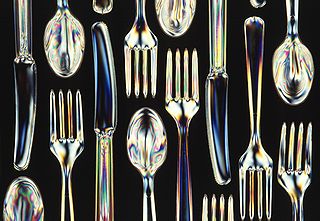
A strain gauge is a device used to measure strain on an object. Invented by Edward E. Simmons and Arthur C. Ruge in 1938, the most common type of strain gauge consists of an insulating flexible backing which supports a metallic foil pattern. The gauge is attached to the object by a suitable adhesive, such as cyanoacrylate. As the object is deformed, the foil is deformed, causing its electrical resistance to change. This resistance change, usually measured using a Wheatstone bridge, is related to the strain by the quantity known as the gauge factor.
Stress–strain analysis is an engineering discipline that uses many methods to determine the stresses and strains in materials and structures subjected to forces. In continuum mechanics, stress is a physical quantity that expresses the internal forces that neighboring particles of a continuous material exert on each other, while strain is the measure of the deformation of the material.

In materials science, photoelasticity describes changes in the optical properties of a material under mechanical deformation. It is a property of all dielectric media and is often used to experimentally determine the stress distribution in a material.
Raymond David Mindlin was an American mechanical engineer, Professor of Applied Science at Columbia University, and recipient of the 1946 Presidential Medal for Merit and many other awards and honours. He is known as mechanician, who made seminal contributions to many branches of applied mechanics, applied physics, and engineering sciences.
Daniel Charles Drucker was American civil and mechanical engineer and academic, who served as president of the Society for Experimental Stress Analysis in 1960–1961, as president of the American Society of Mechanical Engineers in the year 1973–74, and as president of the American Academy of Mechanics in 1981–82.
Cesar Augusto Sciammarella is an Argentine civil engineer who made significant contributions to the field of experimental mechanics. In the last decade, he has extended his pioneering developments in moiré, holography, and speckle interferometry methodologies down to the nanometer level. These efforts have enabled optics to be applied beyond the classical Rayleigh limit, reaching the nanometer range.

Emmanuel E. Gdoutos is a Greek academic, Professor Emeritus at the Democritus University of Thrace and Full Member of the Academy of Athens. He has worked in experimental mechanics, fracture mechanics, composite materials, and sandwich structures. His main scientific accomplishments include the solution of many problems of crack growth under combination of opening-mode and sliding-mode loading which were published in his book: “Problems of Mixed-Mode Crack Propagation." His contributions have been widely recognized worldwide through membership and leadership in scientific societies, national academies and honorary diplomas and awards.
Susan K. Foss was an American engineer. She worked at Deere and Company throughout her career and held numerous service roles in the Society for Experimental Mechanics, including serving as the society's first female president from 1998 to 1999. She died on January 24, 2013.
William MacGregor Murray was an American engineer. He was a professor at the Massachusetts Institute of Technology and held numerous service roles in the Society for Experimental Stress Analysis (SESA) including as the first President of the society from 1943 to 1944. He went by Bill Murray and died on August 9, 1990.
Miklós Imre Hetényi was a Hungarian-American engineer. He was a professor at Stanford University and held numerous service roles in the Society for Experimental Stress Analysis (SESA) including as the second President of the society from 1944 to 1945. His parents were Géza Hetényi and Etelka Jakab (1864–1956). He died at his desk at home on the Stanford campus while working on a structural mechanics book.
August J. Durelli was an Argentine-American engineer. He was a professor at the Illinois Institute of Technology and the Catholic University of America.
Francis Gibbons Tatnall was an American engineer and entrepreneur. He went by Frank and was born to William Francis Tatnall and Lillian Harriett Tatnall. Tatnall worked at Vishay Intertechnology and has been referred to as the spiritual father of strain gages.
Max Mark Frocht was a Polish-American engineer and educator. He was a professor at the Illinois Institute of Technology and founder of the Laboratory for Experimental Stress Analysis.
Milton Maxwell Leven was an American engineer. He was an engineering and manager of Experimental Mechanics at Westinghouse Research Laboratories and held numerous service roles in the Society for Experimental Stress Analysis (SESA) including as the President of the society from 1956 to 1957. He was born to Jacob Leven and Anna J Leven of Russian descent in Pennsylvania. He went by Milt.
Johann Hans Meier was an American engineer who contributed to the development of the strain gauge.
Charles E. Taylor was an American engineer. He was a Professor of Theoretical and Applied Mechanics (TAM) Department at the University of Illinois Urbana-Champaign. He was known as Chuck.
Greer Ellis was an American engineer and inventor of Stresscoat brittle coating for non-destructive stress analysis.
Dominick J. DeMichele was an American engineer and founder of the International Modal Analysis Conference (IMAC). He went by Dick.
Clarence R. Smith was a Structures Design Specialist in the Fatigue Laboratory at General Dynamics/Convair.
Daniel Post is an American engineer and was a professor at the Virginia Tech.



